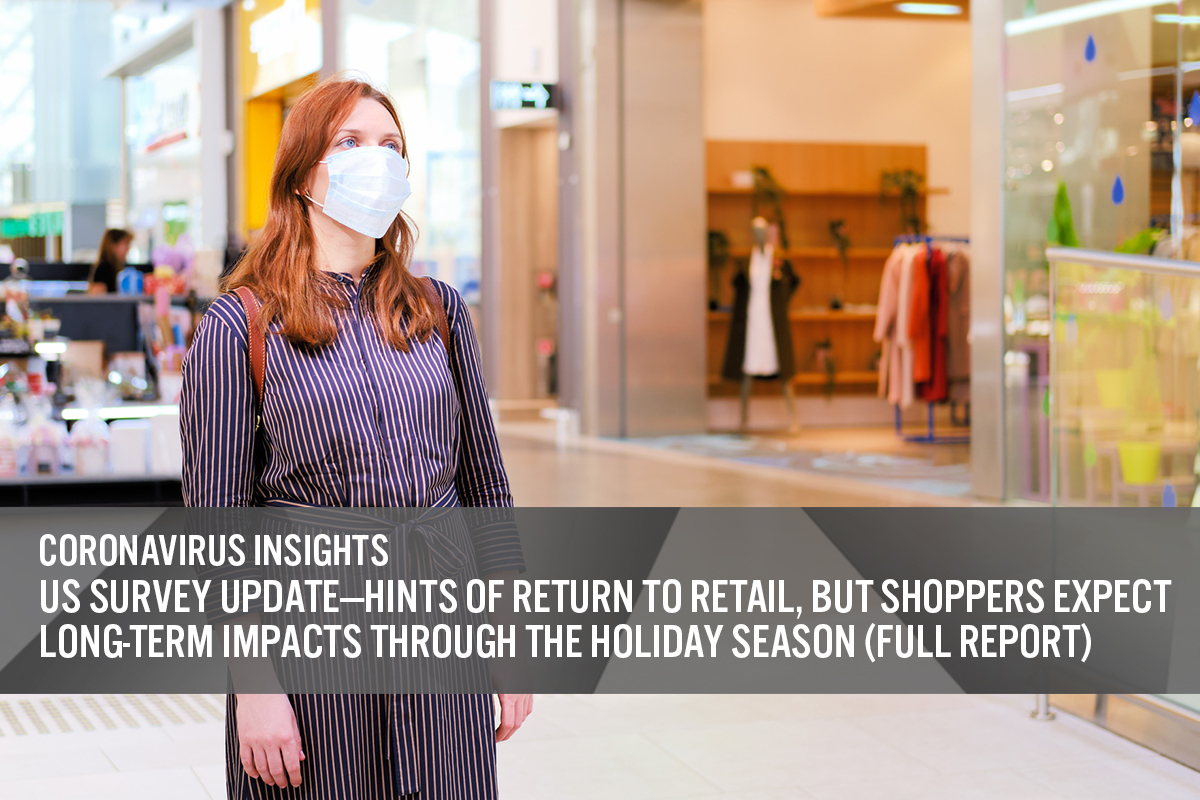
DIpil Das
Introduction
This report presents the results of Coresight Research’s latest weekly survey of US consumers on the coronavirus outbreak, undertaken on May 6. This report explores the trends we are seeing from week to week, following prior surveys on April 29, April 22, April 15, April 8, April 1, March 25 and March 17–18.Looking Beyond Lockdown
Almost Half of US Consumers Expect To Avoid Shopping Centers This week, 68.4% of all respondents anticipated avoiding some kind of public places or travel after lockdowns end. This number is down from 72.9% last week. We saw some moderation in expectations to avoid most types of public spaces this week. As we discuss later, some other metrics suggest a slight increase in consumers’ willingness to shop in stores after lockdown—although we must not read too much into one-week changes.- Almost half of all consumers expect to avoid shopping centers/malls after lockdown: 46% this week versus 50% last week.
- One exception was food-service locations, with a further increase in the proportion of respondents expecting to avoid restaurants, bars or coffee shops.
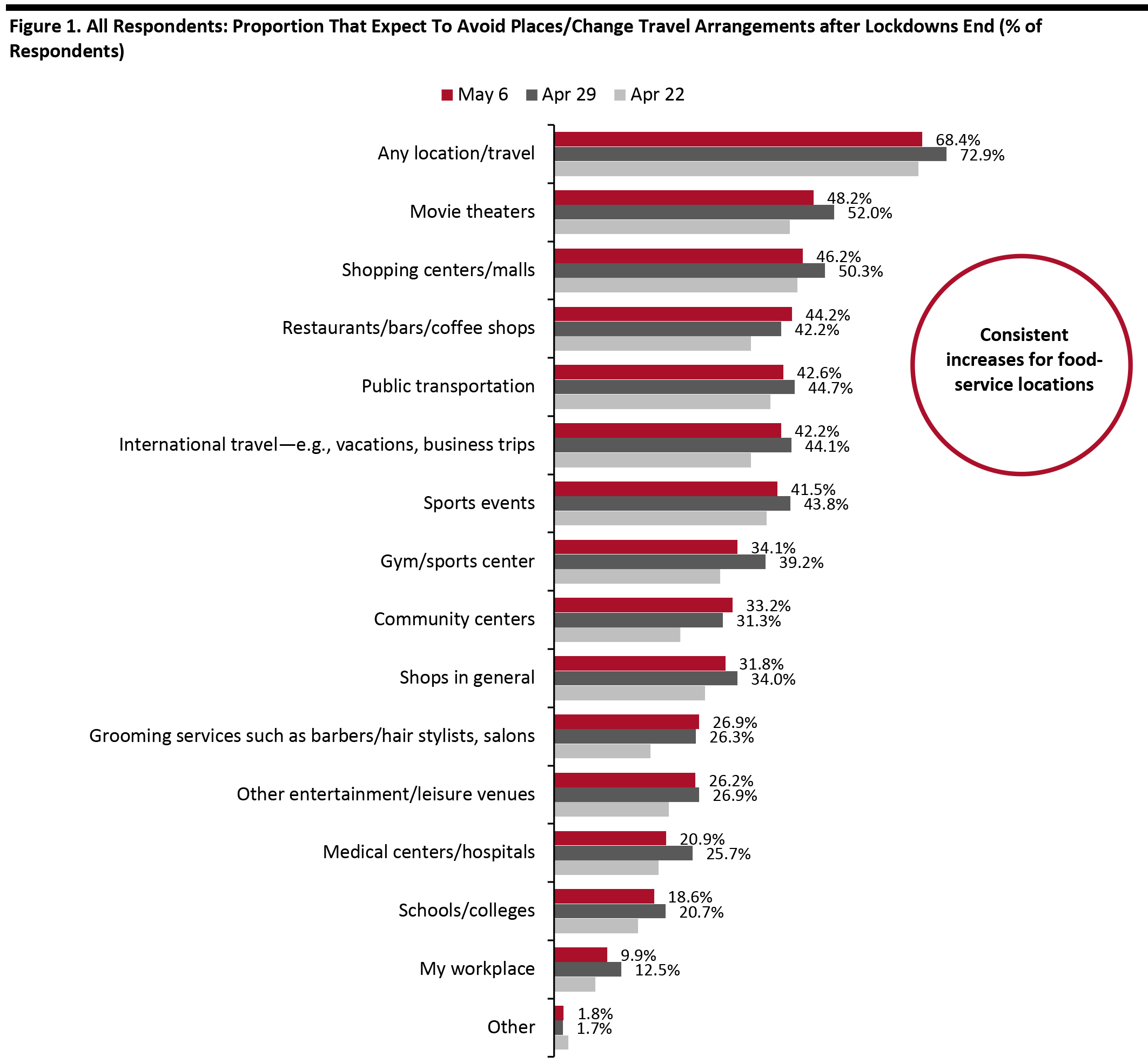 Respondents could select multiple options
Respondents could select multiple options Base: US Internet users aged 18+
Source: Coresight Research [/caption] Older Millennials’ Expected Avoidance Declines At the total level, the week-over-week change in willingness to visit public places is not major and is simply a reversal of the prior week’s uptick. Once we look at age, however, we see a more meaningful shift in attitudes among those aged 30–44, with an approximate 10-percentage-point drop in the proportion of this age group expecting to retain avoidance behaviors. This age group drove the week-over-week reduction in expected avoidance of shopping centers/malls, charted above. [caption id="attachment_109297" align="aligncenter" width="700"]
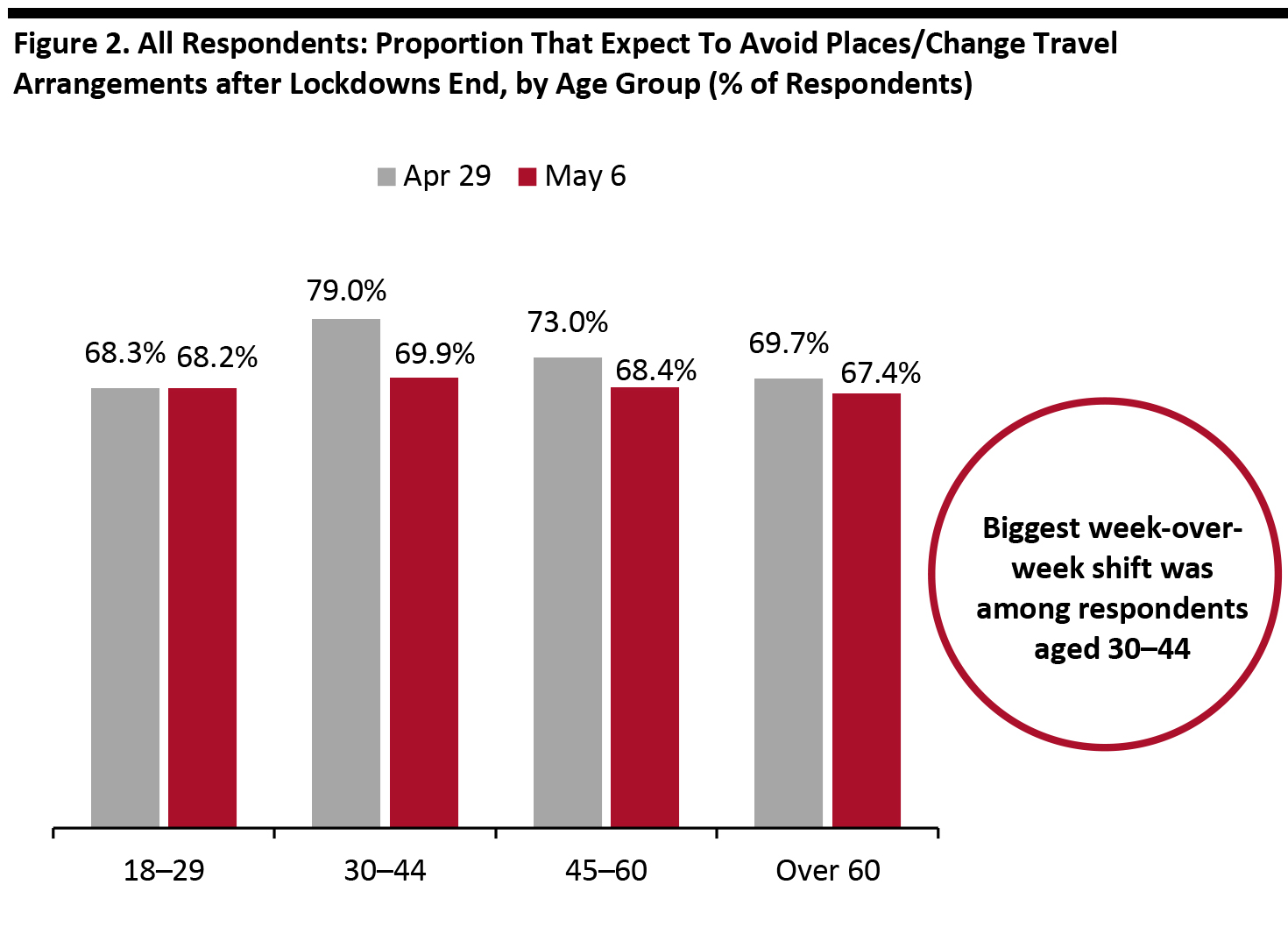 Respondents could select multiple options
Respondents could select multiple options Base: US Internet users aged 18+
Source: Coresight Research [/caption] More Shoppers Expect Long-Term Impacts We asked three questions in which respondents were required to estimate the timescale of coronavirus impacts. · We asked those respondents who expect to take avoidance action how long they expect to be doing so for. · We asked those making fewer or more purchases of any categories how long they expect it will be before their spending bounces back to normal levels. · We asked all respondents how long they think the severe effects of the outbreak will impact life in the US. All three questions returned an increased proportion of respondents expecting long-term impacts, week over week. We present the findings in the following sections. Avoidance Behaviors: One in Three Expects To Avoid Public Places for More Than Six Months Among those expecting to avoid public places or travel after lockdowns end, more than one in three expect to take such action for more than six months: 34.4% this week versus 31.0% last week. A total of 72% expect it to be three months or longer (versus 70.5% last week), and only a fraction of respondents think they will do so for less than one month. These findings underscore the medium-term challenge that retailers will face in encouraging some shoppers back to discretionary brick-and-mortar formats, even though lower store traffic would assist with post-lockdown social distancing in store. [caption id="attachment_109298" align="aligncenter" width="700"]
 Base: US Internet users aged 18+ who expect to avoid places/change travel arrangements after lockdowns end
Base: US Internet users aged 18+ who expect to avoid places/change travel arrangements after lockdowns end Source: Coresight Research [/caption] Spending Bounce Back: Almost 30% Expect To Retain Changed Spending Patterns for More Than Six Months Among those who have changed their spending levels—either buying more or less of any categories—almost 30% expect it to be more than six months from now before their spending patterns return to normal, up from one-quarter last week. That six-month-plus window takes us up to November at the earliest—the start of the holiday season. We see slightly higher expectations of a long-term impact among those making fewer purchases: 31.9% of this group expect to return to pre-crisis spending patterns only in more than six months’ time (Figure 4).
- We show what consumers are buying more of and less of in a separate section, later in this report.
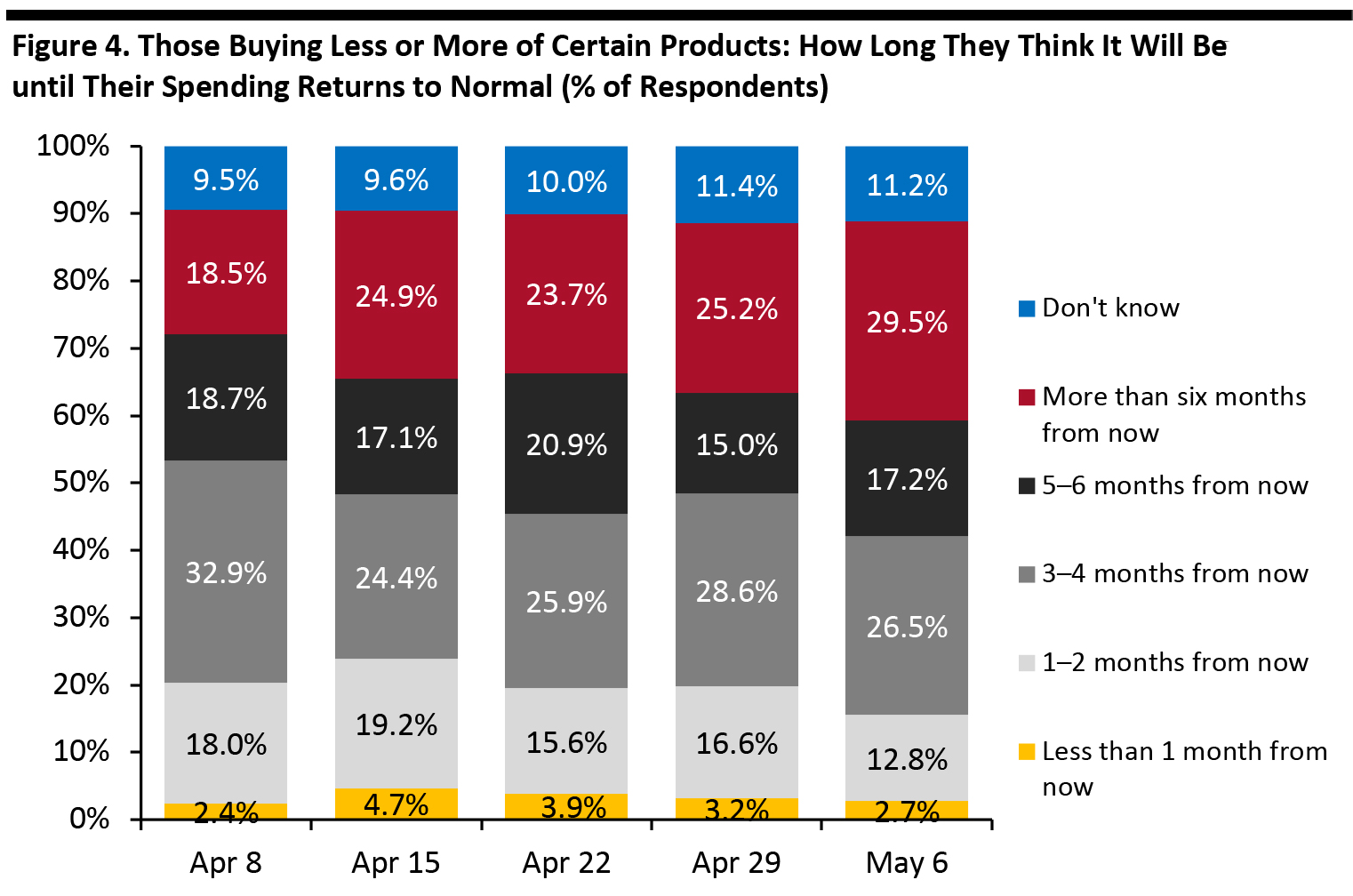 Base: US Internet users aged 18+ who are purchasing any products more or less, because of the coronavirus outbreak
Base: US Internet users aged 18+ who are purchasing any products more or less, because of the coronavirus outbreak Source: Coresight Research [/caption] [caption id="attachment_109300" align="aligncenter" width="700"]
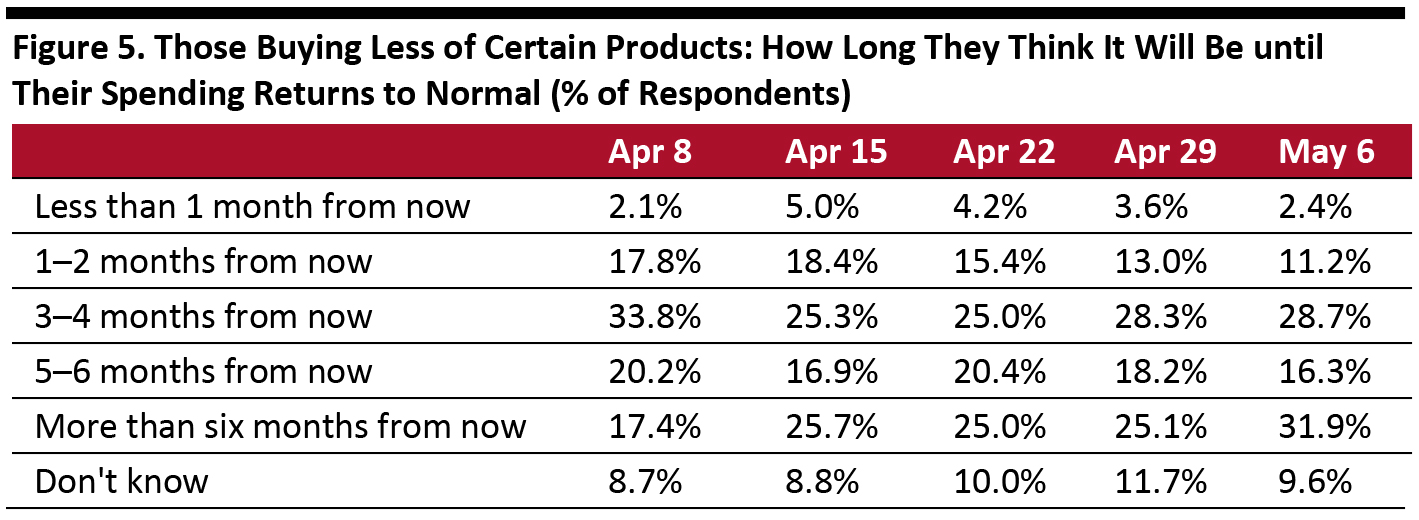 Base: US Internet users aged 18+ who are purchasing any products less, because of the coronavirus outbreak Totals may not sum due to rounding
Base: US Internet users aged 18+ who are purchasing any products less, because of the coronavirus outbreak Totals may not sum due to rounding Source: Coresight Research [/caption] Impact on Everyday Life: Over Half of Consumers Expect the Crisis To Last More Than Six Months This week, consumers’ expectations of the length of the crisis jumped: Fully 54.0% now expect the severe impact of the outbreak to last more than six months from its start, up from 41.3% last week. This timescale implies that the severe impacts will run up to the holiday season. Some 87.7% expect the severe impact to last three months or more, broadly level with 87.3% last week. [caption id="attachment_109301" align="aligncenter" width="700"]
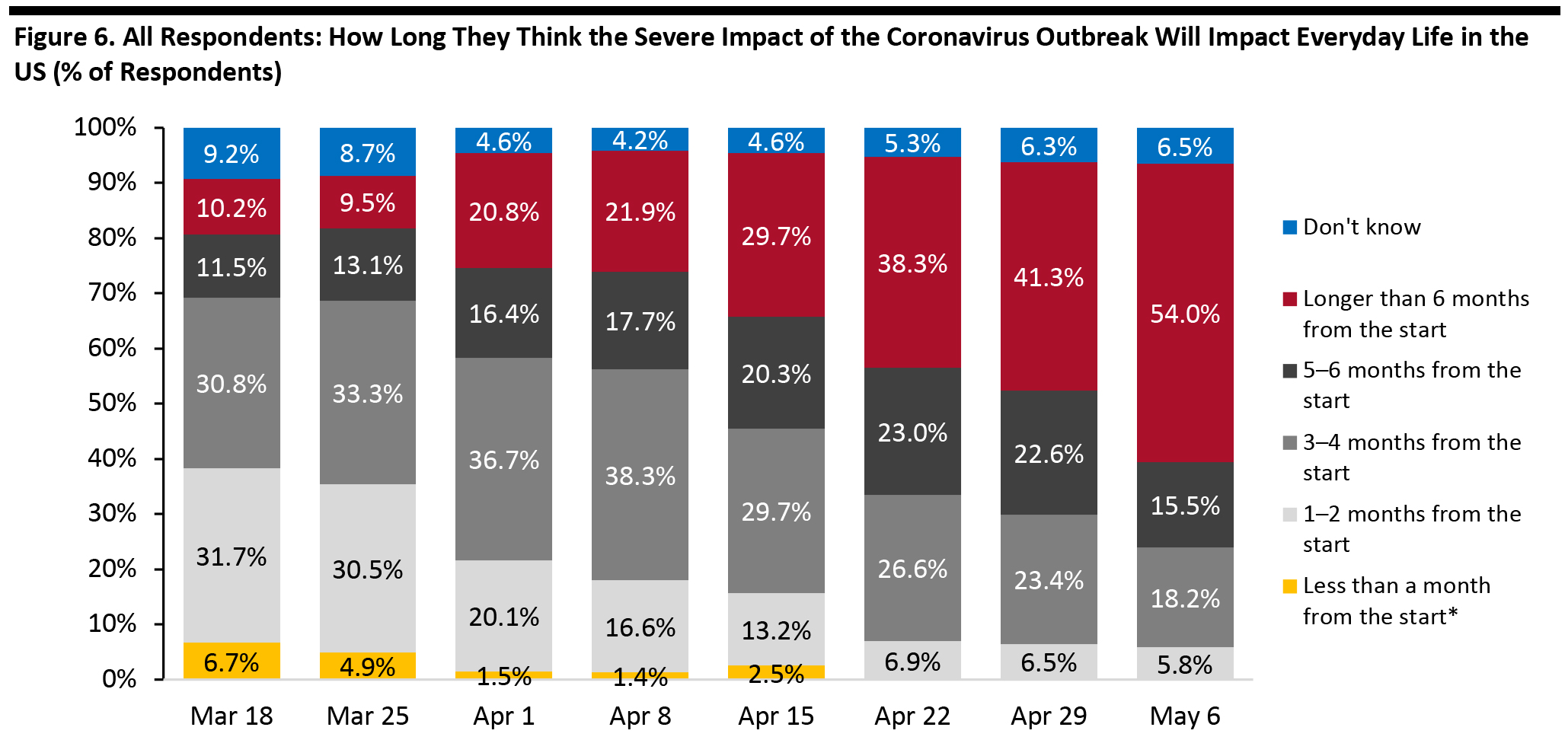 Base: US Internet users aged 18+
Base: US Internet users aged 18+ *Not provided as an option after April 15
Source: Coresight Research [/caption] Two-Thirds Expect To Retain Changed Behaviors for the Long Term Each week, we ask respondents whether they think they will keep some of the behaviors they have adopted during the coronavirus crisis. In recent weeks, this metric has leveled off (and is perhaps moderating very slightly), with around two-thirds of all consumers expecting to retain some behaviors over the long term. [caption id="attachment_109302" align="aligncenter" width="700"]
 Base: US Internet users aged 18+
Base: US Internet users aged 18+ Source: Coresight Research [/caption] Among those expecting to retain changed behaviors, we have seen consistent or near-consistent upward trends in the following:
- Less physical interaction—reflecting a growing realization that post-lockdown normality will involve physical distancing.
- Visiting public places less often—which is likely to hit shopper traffic to brick-and-mortar retail formats, but which could help retailers enforce social distancing in stores in the near term.
- The proportion of respondents expecting to switch retail purchases from stores to e-commerce fell to 38.8% this week versus 43.6% last week.
- This week, 29.7% said they expect to shop less overall, versus 31.0% last week.
- The percentages below are proportions of respondents who expect to retain changed behaviors.
 Respondents could select multiple options *Not provided as an option before May 6
Respondents could select multiple options *Not provided as an option before May 6 Base: US Internet users aged 18+ who expect to behave differently in the long term/retain changed ways of living from the outbreak
Source: Coresight Research [/caption] In the chart below, we focus on trending data in two of the metrics charted above. We represent these as a proportion of all respondents, to represent consumers overall, rather than as a proportion of those expecting to retain changed behaviors (which is what is charted above). Rebased to all respondents, the overall upward trends are more distinct, although these have tended to level off in the past couple of weeks. This week, we saw a moderation in the proportion of all consumers expecting to shop more online and less in store, to 24.9%. Shopping less overall moderated slightly, while there was a plateau in visiting public spaces less often. One reading could be that some shoppers—perhaps those bored or frustrated with lockdowns—are now more eager to return to a kind of normality, which includes shopping in stores, resulting in a slight backpedaling on expectations. We will watch this trend in the coming weeks to see if it is borne out as retailers begin to reopen stores. [caption id="attachment_109304" align="aligncenter" width="700"]
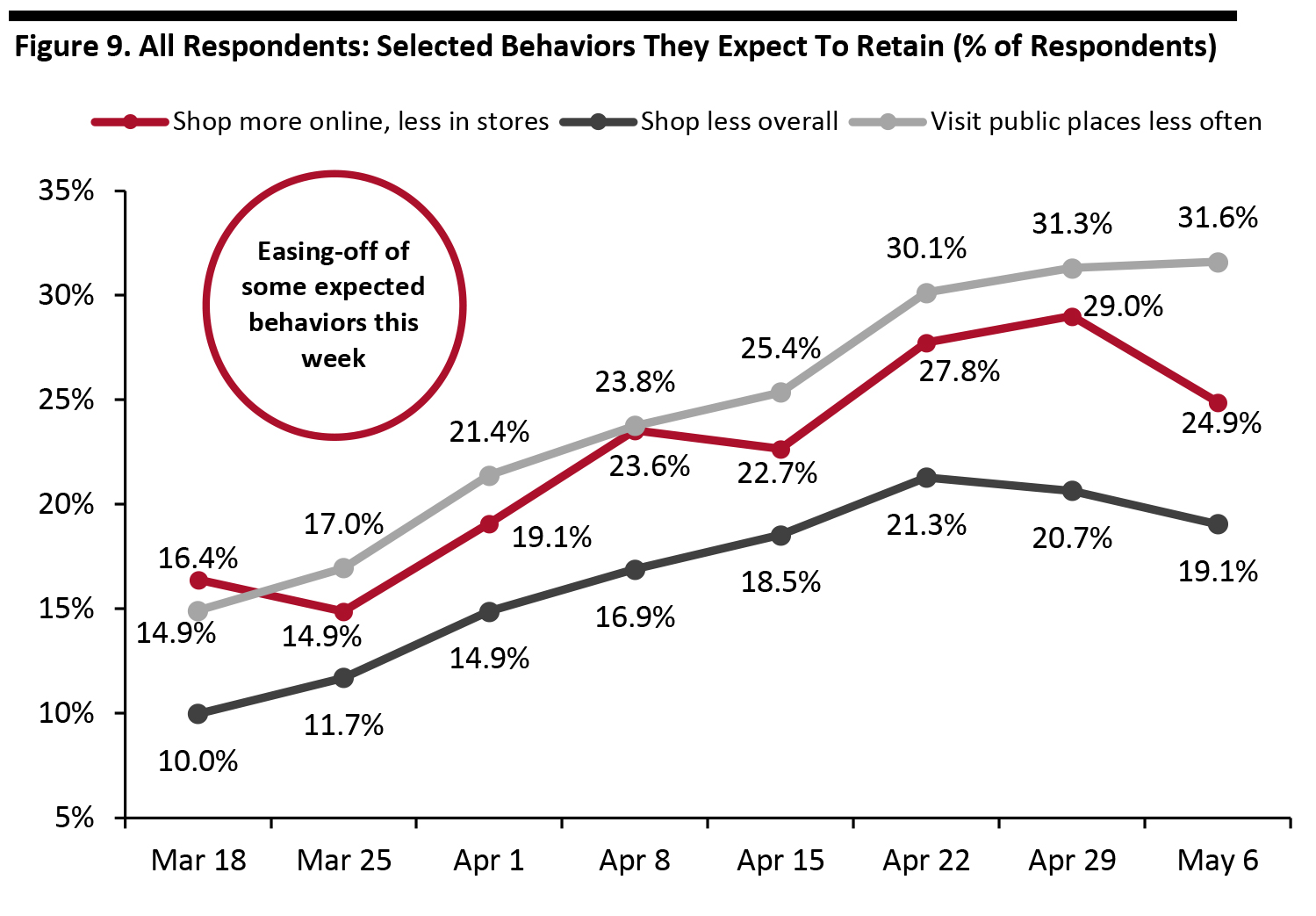 Base: US Internet users aged 18+
Base: US Internet users aged 18+ Source: Coresight Research [/caption]
Reviewing Trend Data in Purchasing Behavior
What Consumers Are Buying More Of and Less Of This week, we saw a moderation in those buying more or less. The trends charted below suggest most metrics may be past their peak, possibly reflecting a settling of consumer behaviour until lockdowns end—that is when we expect to see the next major shifts.- Note, buying more of certain categories and buying less of certain categories were not mutually exclusive options, so respondents could answer yes to both.
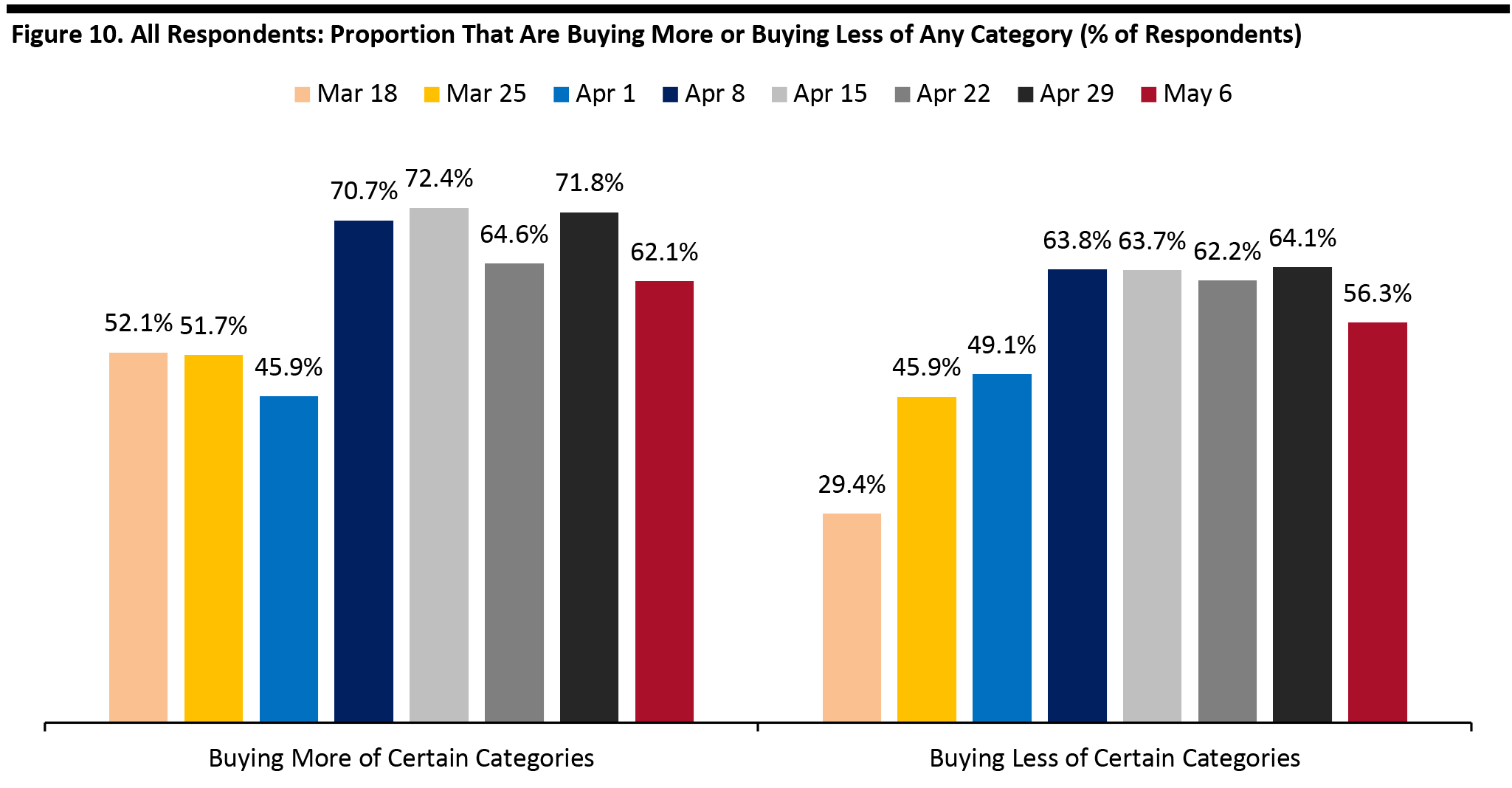 Base: US Internet users aged 18+
Base: US Internet users aged 18+ Source: Coresight Research [/caption] Buying more: Food and other essentials continue to be net beneficiaries. Consumers continue to turn to media products and streaming. Buying less: Apparel continues to be the number-one category for cutbacks, but this week we saw the proportion of respondents cutting back ease to 34.8%, from 41.3% last week (we show trended data in Figure 12). Furniture/home and beauty remained the next most-cut categories, and they saw significant week-over-week reductions in the proportion of consumers cutting their purchases as well. Ratio of less to more: The ratio of those purchasing less to those purchasing more for clothing and footwear stood at 5.3 this week versus 5.2 last week. The ratio for furniture, furnishings and home improvement was 4.0 this week versus 4.5 last week. Beauty products stood at 3.2 this week versus 3.4 last week. [caption id="attachment_109306" align="aligncenter" width="700"]
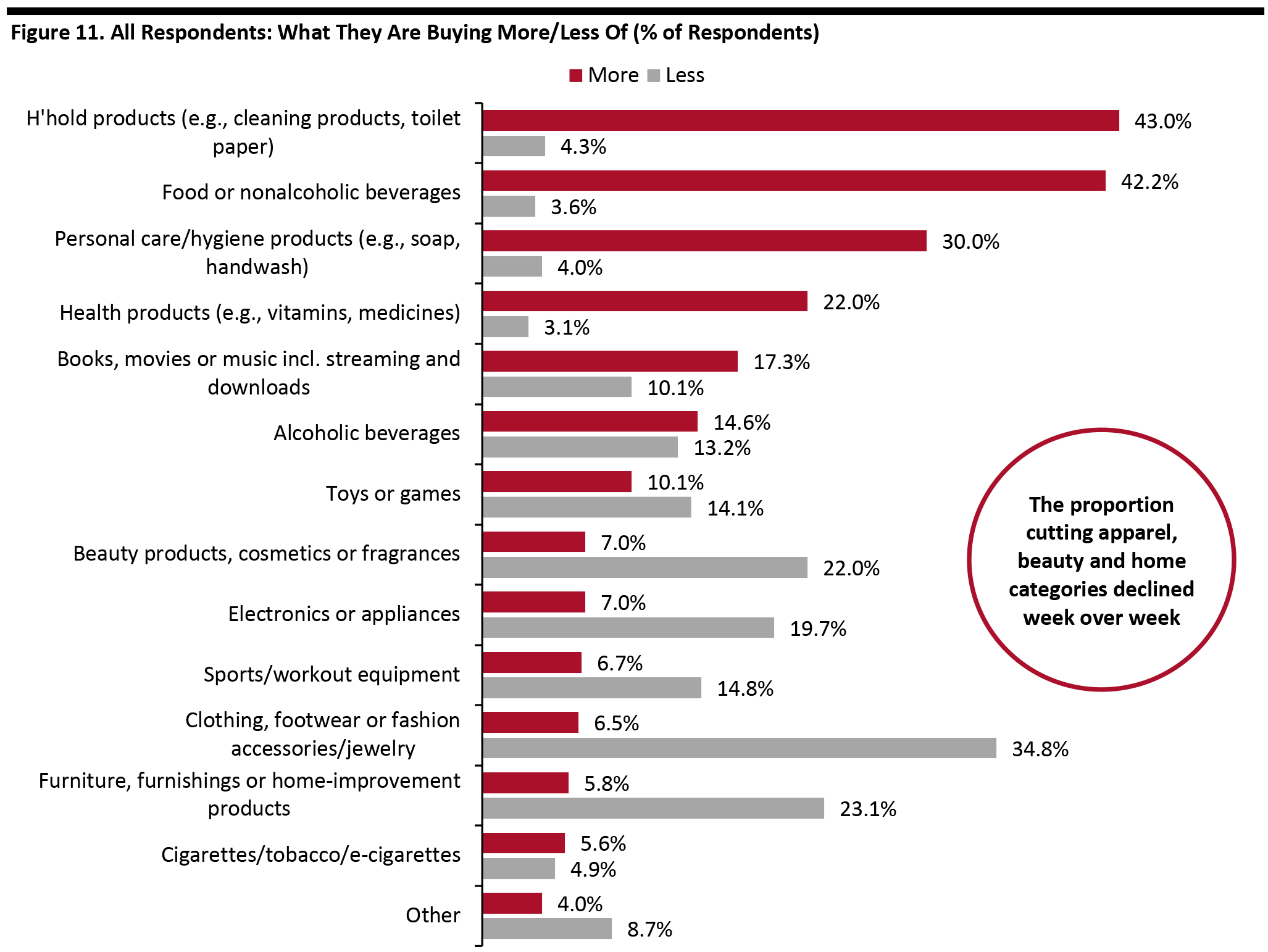 Respondents could select multiple options
Respondents could select multiple options Base: US Internet users aged 18+
Source: Coresight Research [/caption] [caption id="attachment_109307" align="aligncenter" width="700"]
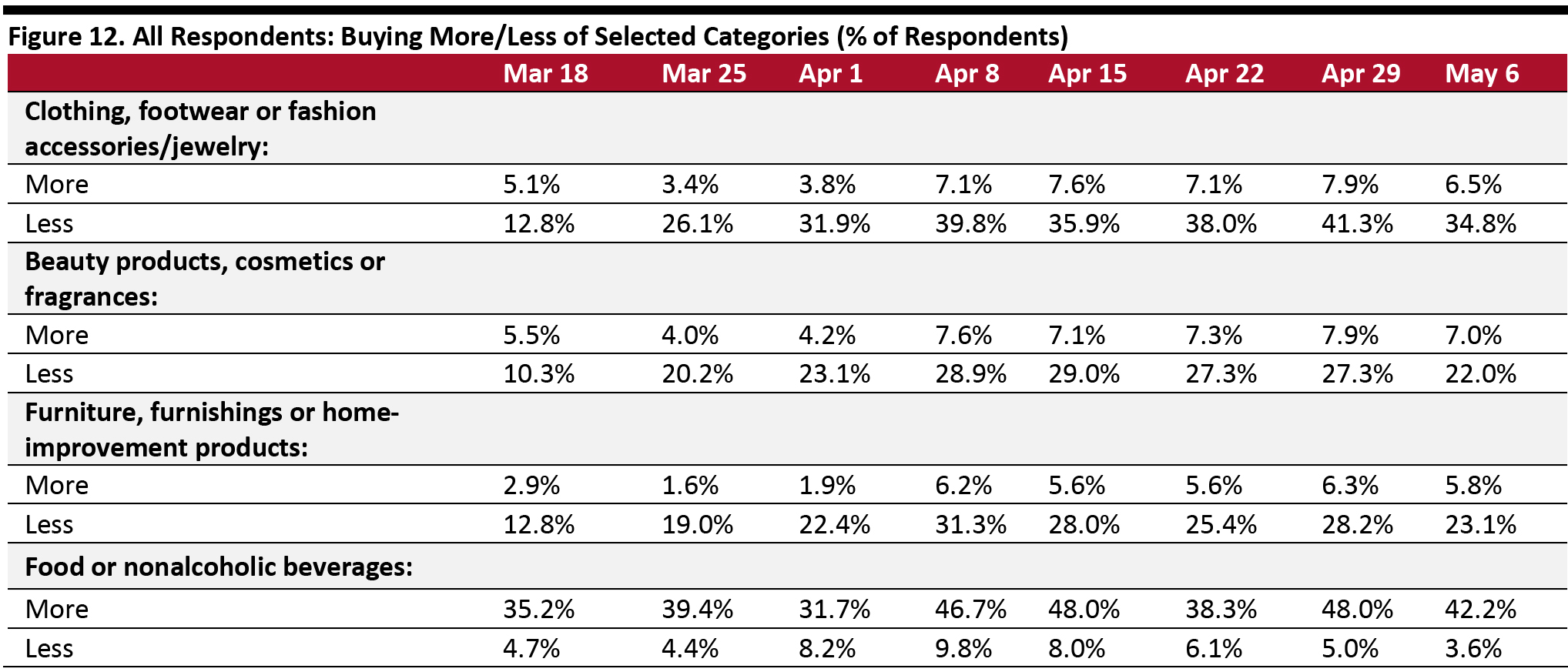 Base: US Internet users aged 18+
Base: US Internet users aged 18+ Source: Coresight Research [/caption] Two-Thirds Are Switching Spending Online The proportion of consumers switching spend to e-commerce has broadly leveled off, at two-thirds. This plateauing further suggests that lockdown shopping habits have settled after previous fluctuations. [caption id="attachment_109308" align="aligncenter" width="700"]
 Base: US Internet users aged 18+
Base: US Internet users aged 18+ Source: Coresight Research [/caption] What They Are Buying More Of Online Among the respondents making more purchases online, we saw everyday household products and health products continue to fall back—likely reflecting many consumers turning to their stockpiled supplies. Furniture and home-improvement categories saw a further upswing this week, likely supported by seasonal demand for spring/summer home and outdoor-living products. We saw a stabilization in the proportion buying more clothing or footwear online—although the general trend has been for this metric to increase. The figures below are a proportion of those who are buying more online in general. Considered as a proportion of all respondents (representing consumers in general), buying more apparel online stood at 16.1% this week, versus 15.9% last week—not a significant change. [caption id="attachment_109309" align="aligncenter" width="700"]
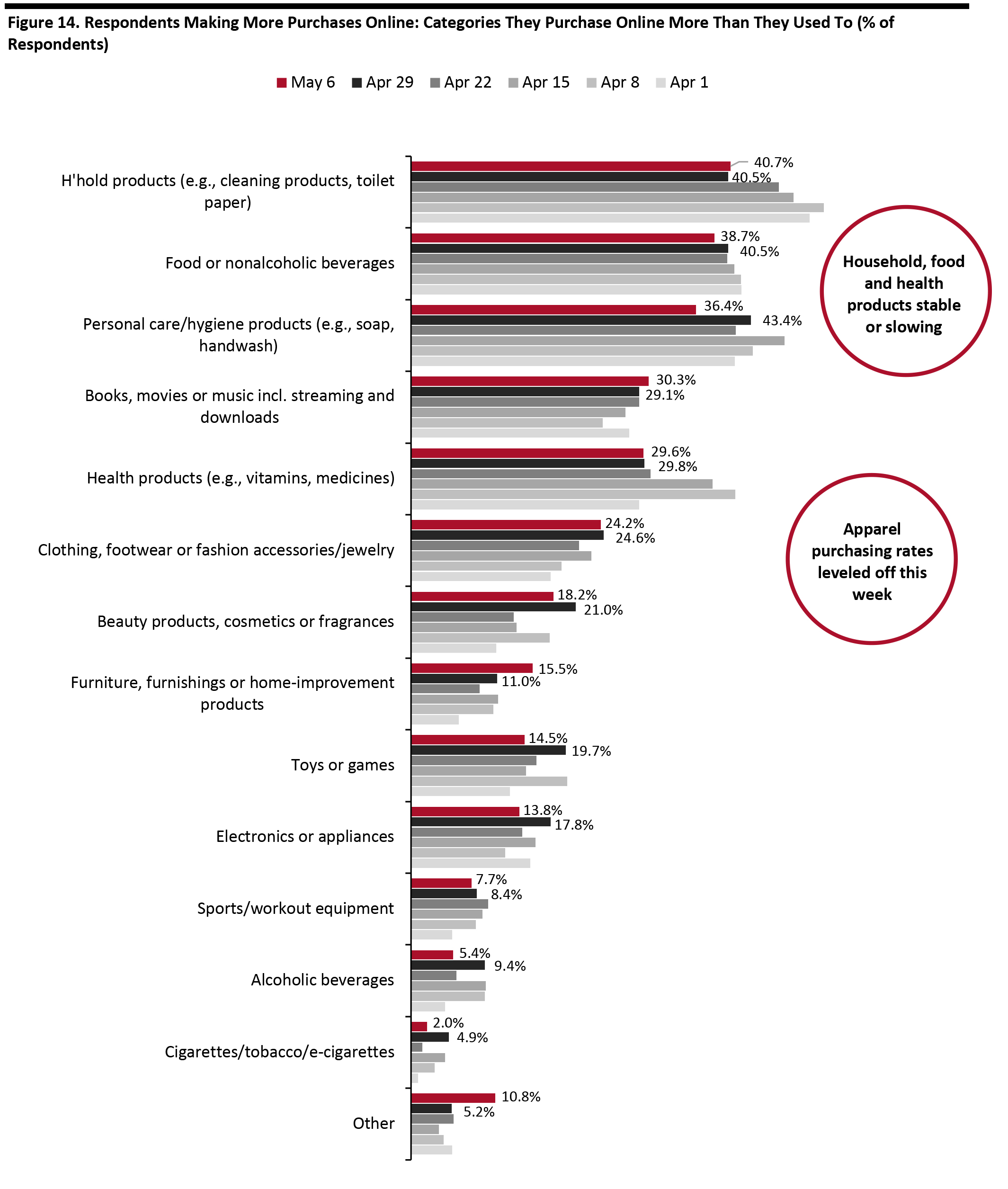 Respondents could select multiple options
Respondents could select multiple options Base: US Internet users aged 18+ who make more purchases online than they did before the coronavirus outbreak
Source: Coresight Research [/caption]
Shoppers’ Concerns
Levels of concern at the coronavirus outbreak have remained steady, with just over half extremely concerned. [caption id="attachment_109310" align="aligncenter" width="700"] Question not asked on April 22
Question not asked on April 22 Base: US Internet users aged 18+
Source: Coresight Research [/caption] We asked respondents to choose from a selection of statements related to employment and income. We have seen some fluctuation in the proportion of respondents worried about what may happen. This week, a total of 35.0% were worried about losing their job or part of their income, versus 42.0% last week. [caption id="attachment_109311" align="aligncenter" width="700"]
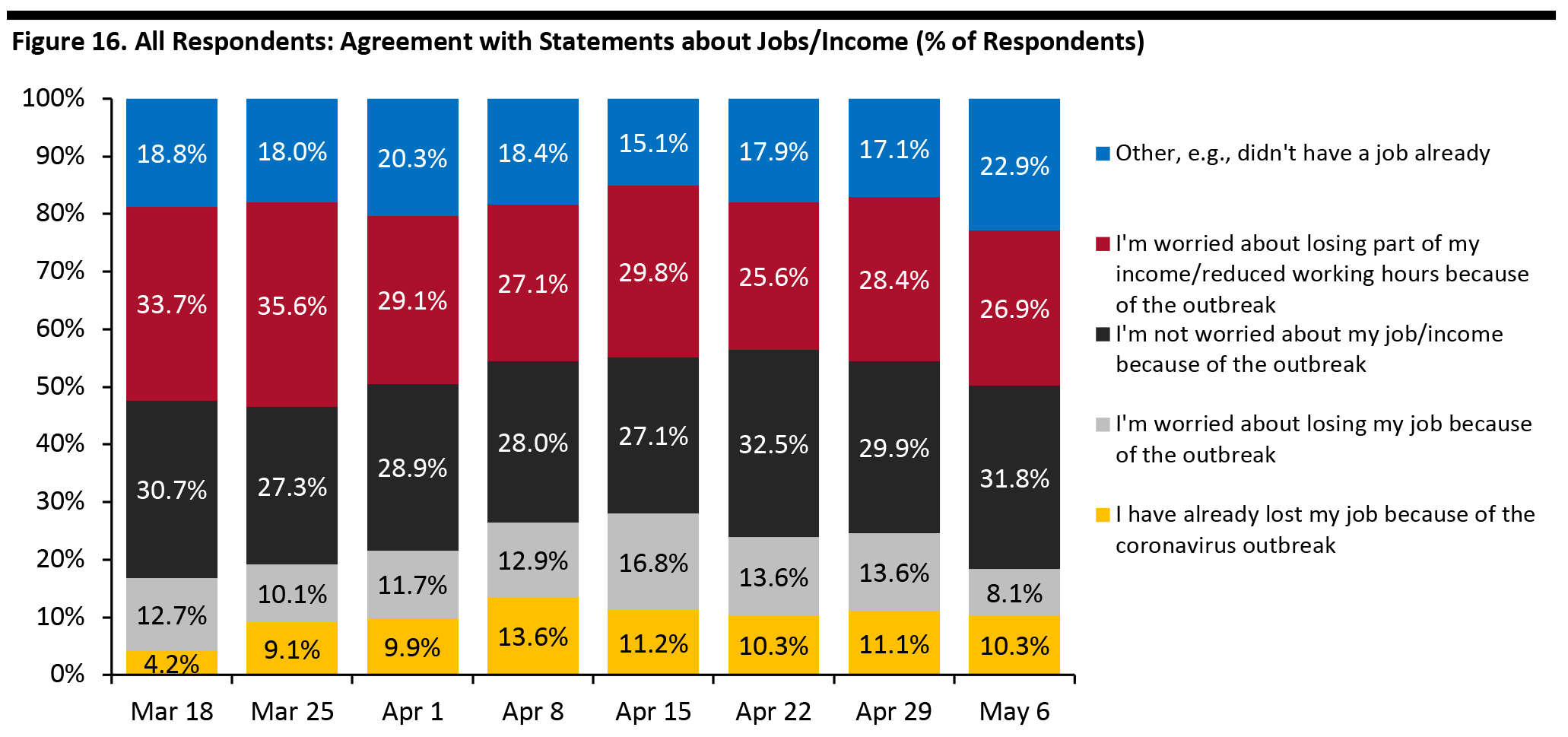 Base: US Internet users aged 18+
Base: US Internet users aged 18+ Source: Coresight Research [/caption]